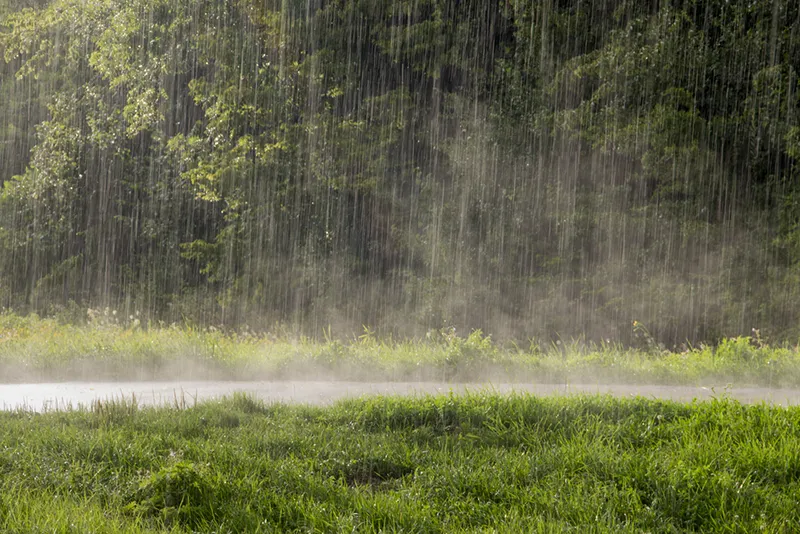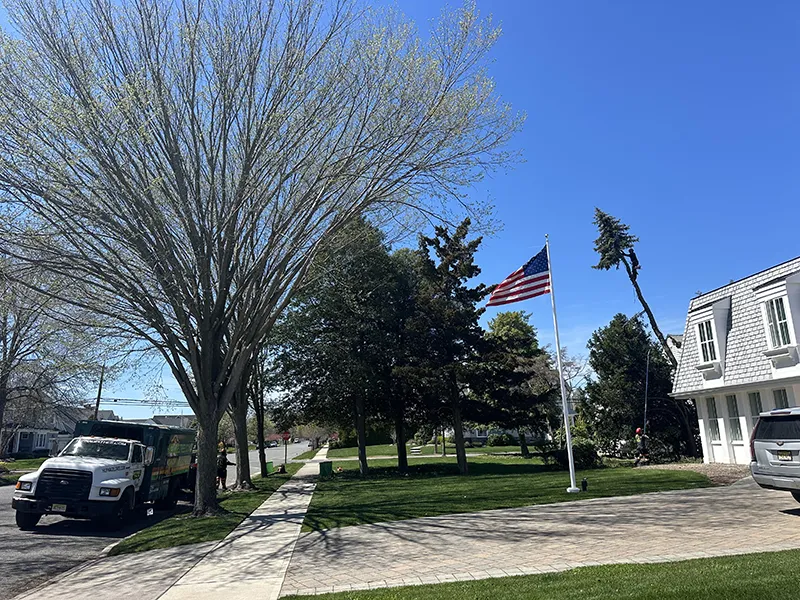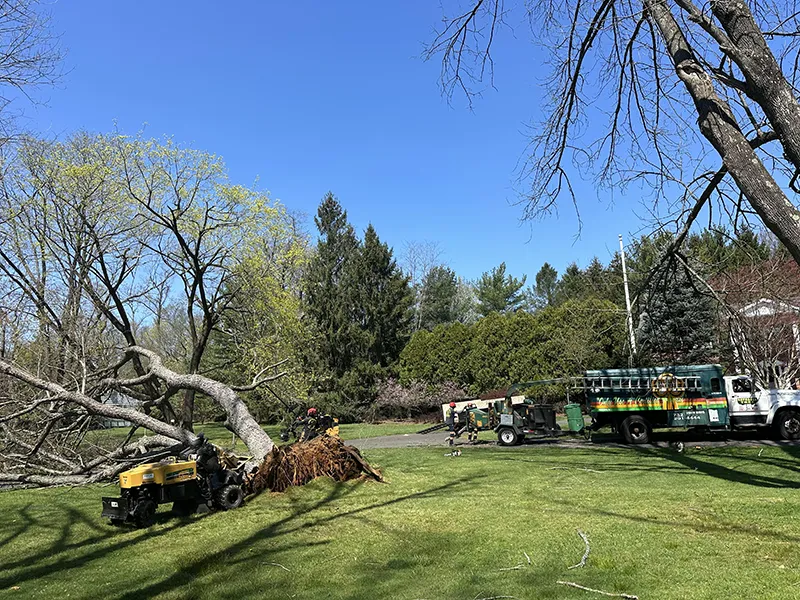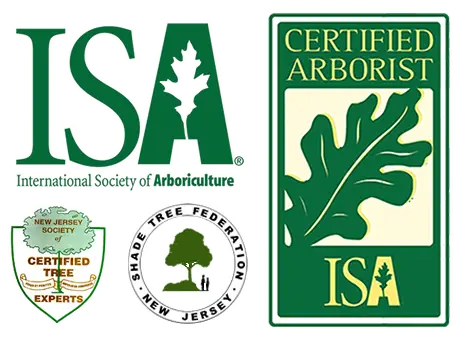In This Article ...
Overview of Recent Weather Events and Their Impact on Trees

The weather conditions in Middletown, NJ this past April have been nothing short of extraordinary, serving as a stark reminder of the dynamic and sometimes unpredictable nature of our environment. The season was marked by severe windstorms that swept through the region, reaching speeds that are not commonly seen in our area. These high winds have not only disrupted daily life but have also posed serious threats to the structural integrity and health of our trees. The sheer force of these winds has the capability to bend and twist even the sturdiest trees, leading to weakened limbs and, in some cases, uprooting trees entirely.
In addition to the wind, Middletown has experienced periods of heavy rainfall, which have compounded the challenges posed by the windstorms. The ground, saturated with water, has become unstable, a condition that significantly diminishes the soil’s ability to anchor trees securely. This saturation leads to a softened foundation where trees can easily become dislodged during strong wind events. Moreover, the excessive moisture creates an ideal environment for fungal growth and other pathogens that can attack tree roots, further weakening trees from below ground level and making them more susceptible to falling.
Amidst the wind and rain, the community was also shaken by an unusual seismic event—a 4.7 magnitude earthquake centered near Whitehouse Station. While minor in comparison to earthquakes in more seismically active regions, even small tremors can have significant effects on the local environment. The earthquake’s vibrations traveled through the ground, potentially loosening the soil around tree roots and disrupting the delicate balance that keeps trees stable. This seismic activity, though brief, adds another layer of risk for trees in our area, emphasizing the need for thorough inspections and proactive tree care to mitigate these combined natural threats.
Understanding the Risks to Trees from High Winds


High winds can significantly impact tree stability and health, particularly for those trees that are older or have pre-existing vulnerabilities due to disease or previous damage. The structural integrity of a tree can be compromised over time by various factors such as pest infestations, fungal diseases, and prior weather-related injuries. When high winds occur, these compromised trees are at a higher risk because the force exerted by the wind can intensify any existing weaknesses. This can lead to partial or complete structural failures, such as broken limbs or split trunks.
Additionally, the root systems of trees play a crucial role in their ability to withstand high winds. Trees with shallow root systems, or those grown in compacted or poor-quality soil, may not have the anchor needed to hold up against strong wind forces. This situation is exacerbated in urban or suburban environments where natural soil conditions are often altered or obstructed by human activities, limiting root growth and spread. When high winds hit, these trees may tilt or uproot entirely, posing risks not only to the trees themselves but also to nearby property and personal safety.
Early recognition and management of wind damage are essential. After a windstorm, it’s advisable for property owners to inspect their trees for signs of distress. This includes checking for branches that are hanging or broken and might fall, assessing for any new leaning in the tree’s stance, and examining the ground around the tree for uplifted soil or exposed roots, which can indicate destabilization. Engaging a certified arborist to conduct a detailed risk assessment can help diagnose less obvious damage and recommend appropriate interventions such as pruning, cabling, or in some cases, removal to ensure safety and preserve the tree’s health where possible. Regular maintenance, informed by expert advice, helps mitigate the risks posed by high winds and ensures the longevity and safety of trees in vulnerable landscapes.
The Effects of Excessive Rainfall on Tree Stability

The implications of excessive rainfall are less immediately visible but no less significant. Prolonged rainfall saturates the soil, reducing its ability to effectively support the weight and root system of trees. This waterlogged soil can lead to instability in trees, making them more susceptible to falling during windstorms. Additionally, excessive moisture can foster the growth of root diseases, which weaken the tree from below the surface. It’s essential for property owners to be aware of the soil condition around their trees and to seek professional assessments when the ground remains wet for extended periods.
Earthquake Impacts on Local Tree Populations
The recent 4.7 magnitude earthquake near Whitehouse Station on April 5th, although not devastating, has certainly introduced a significant concern regarding the stability of tree populations in and around Middletown, NJ. While earthquakes are relatively rare in our region, the seismic activity experienced was enough to jolt the community and its environment. The vibrations from the quake can cause substantial shifts in the soil structure, which may not be immediately apparent but can have long-lasting effects on tree stability.
When an earthquake occurs, the rapid shaking can disrupt the compactness of the soil, especially in areas with sandy or loose earth. This disruption reduces the friction among soil particles, making it less cohesive and more fluid-like, which undermines the support system of tree roots. For trees, this means a reduced grip on their foundational footing, raising the risk of toppling under less extreme conditions than would normally pose a threat. This is particularly critical for taller or top-heavy trees, which rely heavily on the depth and strength of their root systems for stability.
Furthermore, the aftermath of such shaking may not be limited to immediate loosening of the soil. It can also lead to increased air pockets within the soil profile, which further decreases root-to-soil contact and can exacerbate the drying of soil, making trees even more susceptible to windthrow during high winds. It’s imperative for property owners to conduct post-earthquake assessments of their trees, particularly examining for signs such as leaning trunks, exposed roots, or cracks in the soil near the base of the trees, which are clear indicators of potential instability. In light of these risks, consulting with a certified arborist becomes even more crucial to ensure the continued safety and health of our arboreal surroundings.
Preventive Measures and the Importance of Regular Tree Assessments

Comprehensive Tree Evaluations
Preventive care starts with regular tree evaluations, which are essential in identifying potential hazards before they lead to significant issues. These evaluations involve a thorough inspection of a tree’s overall health, from its tallest branches to its deepest roots. Certified arborists look for signs of stress or disease, such as unusual leaf discolorations, fungi growth, or bark abnormalities. These indicators can suggest deeper issues like nutrient deficiencies or internal decay, which are often exacerbated by severe weather conditions. By catching these signs early, we can apply targeted treatments or interventions that help mitigate the risk of tree failure during storms or other stressful conditions.
Advanced Pruning Techniques
Proper pruning is a cornerstone of tree care that serves multiple purposes: it helps manage the shape and weight of the tree, ensures better light penetration and air circulation within the canopy, and removes potentially dangerous dead or weak branches. However, pruning is not just about cutting branches; it requires an understanding of tree biology to make the right cuts that promote healthy growth without stressing the tree. Techniques such as crown thinning, crown raising, and crown reduction are employed based on the tree’s specific needs and the surrounding environment. These methods help reduce the wind load on trees, making them less likely to topple in high winds while also maintaining their aesthetic and health.
Soil Health and Stability Assessments
The foundation of a tree’s health lies in the soil it grows in. Regular assessments of soil health and stability are vital for ensuring that trees remain stable and well-nourished. This includes testing soil pH, nutrient levels, and moisture content, as well as examining the compactness of the soil which can affect root growth and water absorption. Improving soil conditions may involve aerating compacted soil to improve oxygen circulation or adjusting soil composition to optimize nutrient uptake. Additionally, maintaining proper drainage is crucial to prevent waterlogging, which can weaken trees and make them more susceptible to falling during extreme weather. By managing these aspects of soil health, we enhance the overall resilience of trees to withstand the varied challenges posed by nature.
Schedule Your Free Tree Risk Assessment Today

Given the recent severe weather events, there has never been a more urgent time to examine the health and stability of your trees. Hufnagel Tree Service offers a free tree risk assessment to help you understand the specific risks your trees might face. Contact us at (732) 291-4444 or visit our website at hufnageltree.com to schedule your appointment. Our friendly and professional staff are ready to assist you in securing the safety and health of your trees.
Schedule Your Seasonal Tree Service

